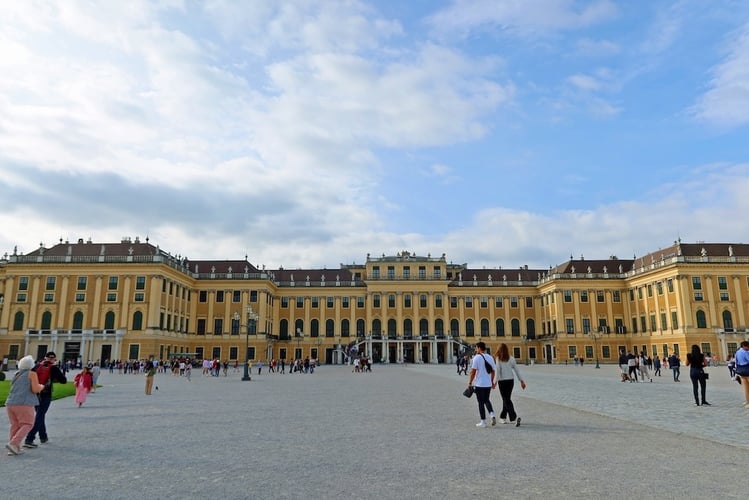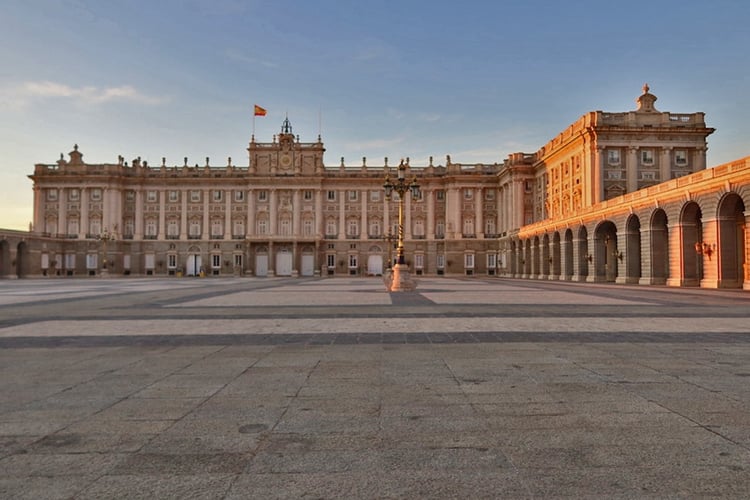A Royal Day Out: The Best Royal Attractions in London
Few cities capture the weight of history quite like London. Its skyline mixes glass skyscrapers with Gothic spires, but London’s true narrative unfolds in its royal landmarks—palaces, parks, and churches that remain at the heart of the city even today.
From the ceremonial grandeur of Buckingham Palace to the centuries of intrigue behind the Tower of London, these two royal attractions in London are more than tourist stops, they are living institutions. Here, the monarchy’s traditions continue in real time: guards still change at the palace gates, royal services still fill Westminster Abbey, and the Crown Jewels still sparkle under the same stone walls that have guarded them for nearly a millennium. However, they are far from the only two London landmarks that you should consider visiting on your next trip!
If you are planning your itinerary and wondering about the best things to do in London, start with its royal side. These are the landmarks in London that define the city’s past and make it unforgettable in the present.
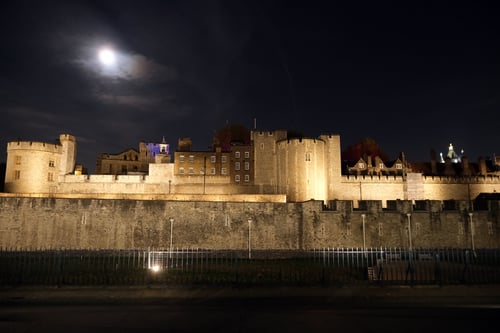
Table of Contents:
- The Must-See Royal Attractions in London
- Bonus Royal Attractions & Experiences in London
- Planning Your Royal Day Out
- In Summary: Royal Attractions to Add to Your London Itinerary
The Must-See Royal Attractions in London
If it is your first time visiting London, start with the royal landmarks that define the city. These are the showstoppers that have shaped British history and still play a role in royal life today. From the centuries of history on display at the Tower of London to the pomp and circumstance seen at Buckingham Palace and the coronations that have taken place in Westminster Abbey for centuries, each of these must-see royal attractions in London offer a glimpse into the pageantry, power, and enduring traditions of the British monarchy.
The Tower of London
Of all the royal attractions in London, none tells the story of the British monarchy quite like the Tower of London. Built by William the Conqueror in the 11th century, this formidable fortress has served as a royal residence, prison, treasury, and even a zoo. However, it is far more famous for its darkest chapters.
Executions, Prisoners, & Disappearances at the Tower of London
Behind its thick stone walls, some of England's most famous prisoners once waited here for their fate. In 1536, Anne Boleyn was beheaded on Tower Green, only a short walk from the ceremonial apartments where she once lived in the days ahead of her coronation. Her cousin Catherine Howard followed her to the scaffold a few years later, and in 1554, Lady Jane Grey, the “Nine Days’ Queen,” met the same tragic end.
However, the most unsettling story is that of the Princes in the Tower. In 1483, the sons of Edward IV, vanished from the Tower of London without a trace. Although their uncle—who would later become King Richard III—is widely suspected of orchestrating their disappearance, no definitive proof was ever uncovered. The fate of the princes remains one of England’s most enduring historical mysteries. Standing in the shadow of the White Tower, it is hard not to wonder what really happened and how much horror these walls have seen.
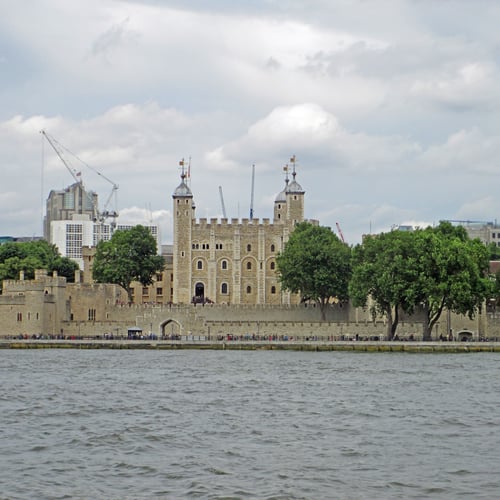
The Tower of London Today
Today, the Tower of London stands as one of London's most remarkable museums - part medieval fortress, part royal vault. The Crown Jewels, housed in the Jewel House, are still used for official occasions, including King Charles III's coronation in May 2023. Seeing the Imperial State Crown up close is nothing short of incredible. Seeing the Crown Jewels at the Tower of London feels both intimate and humbling, a reminder that the British monarchy is as much tradition as it is spectacle.
The Yeoman Warders
Beyond the royal vault, the Tower of London is brought to life by the Yeoman Warders, affectionately known as the Beefeaters. Dressed in their red uniforms, they serve not just as guides but as storytellers, carrying centuries of tradition in their voices. Their tours move effortlessly from fact to folklore, from ghostly sightings to tales of betrayal, making the Tower of London feel less like a museum and more like a living monument.
Yet, despite all of the ceremony and the centuries of history here, the Tower of London can also be a place of quiet reflection. Each November the Tower of London transforms into a powerful tribute to remembrance that honors those lost in war.
The Tower of London Remembers: Poppies for Remembrance Day
For the 80th anniversary of VE Day in May 2025, the Tower of London brought back one of its most powerful and beloved displays - the ceramic poppies that first filled its moat in 2014. Originally created for “Blood Swept Lands and Seas of Red,” the poppies have been reinstalled at the Tower this year and will remain in place through November 11, 2025, offering a moving tribute to those who served and sacrificed during times of war.
In addition to the poppies, the Tower Remembers 2025 exhibition introduces multimedia displays that blend archival recordings, projections, and soundscapes to tell stories from the home front and the battlefield. The experience honors both soldiers and civilians, bringing history to life in a way that feels deeply personal.
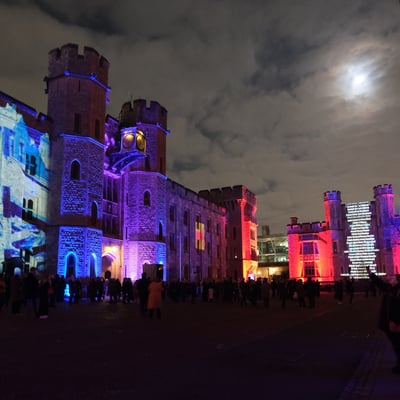
I had the chance to see the after-hours Remembrance Day installation in November 2024, and it was one of the most memorable experiences I have ever had in London. As the lights dimmed across the moat and voices echoed softly through the grounds, the Tower of London transformed. It became reverent, quiet, and incredibly moving.
This year’s extended installation offers visitors that same reflective atmosphere. Unlike the experience in 2024, this year's Remembrance Day events at the Tower of London is included with your general admission tickets to the Tower of London.
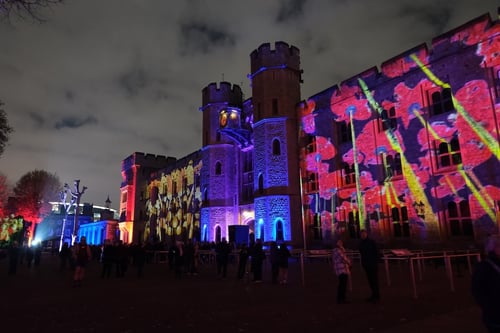
Must-See Sights at the Tower of London
While many visitors come for the Crown Jewels and the poppy displays in early November, there is much more to discover within the Tower of London's walls. Additional must-see sights at the Tower of London include:
- The White Tower: Arguably the most famous castle in the world and the former royal residence within the Tower of London, the White Tower dates back to William the Conqueror. Today, it houses a collection of royal armor and weapons.
- Tower Green: The peaceful courtyard that once served as the site of some of England’s most famous executions, including three English queens.
- The Medieval Palace: Restored royal chambers offering a glimpse into how medieval monarchs lived. The Medieval Palace is surprisingly intimate and beautifully preserved.
- The Ravens: According to legend, if the ravens ever leave the Tower of London, the kingdom will fall. Today, seven ravens are kept under the close watch of the Ravenmaster. I previously mentioned the ravens in my London Travel Blog, but seeing them in person at the Tower of London is always a highlight!
- The Ramparts: Walk the perimeter walls for panoramic views of Tower Bridge and the River Thames, an essential photo stop.
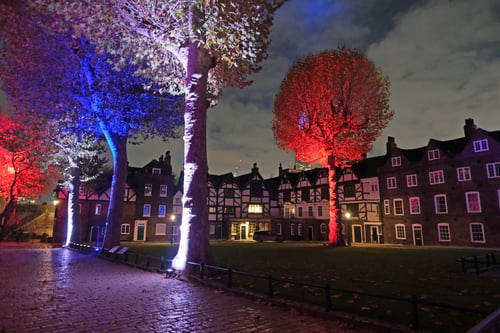
How to Visit the Tower of London: Tickets, Opening Hours, & More
The Tower of London is open daily, typically from 9:00 AM to 5:30 PM.
- Please keep in mind that on Sundays, the Tower of London does not open until 10:00 AM.
- During the autumn and winter months (October through February), the Tower of London closes at 4:30 PM.
- The Tower of London is closed January 1, January 5-6, and December 24-26, annually.
- Parts of the Tower of London may be closed during your visit for conservation work. For information regarding closures, please visit the Tower of London website.
Ticketing Information
I wholeheartedly recommend booking your tickets for the Tower of London online, in advance of your visit. As one of the most popular London landmarks and best royal attractions in London, tickets for the Tower of London can sell out in advance, especially during the summer months.
-
Admission starts £35.80 for adults. Discounted admission is also available for children, students, seniors, and groups. Admission is free for children under the age of five.
-
Entry includes access to the Crown Jewels, the White Tower, and all exhibitions.
-
Yeoman Warder tours are included with your admission and depart every 30 minutes from the main courtyard.
-
All tickets are issued for specific entry times.
Tickets for the Tower of London can be booked directly through the Historic Royal Palaces website. Official tickets can also be secured through our affiliate partner, GetYourGuide. Booking your tickets through GetYourGuide allows you to pay in your home currency (like USD), which can help you avoid foreign transaction fees. Plus, at no cost to you, we may earn a small commission!
London City Pass by MegaPass
If you are planning to visit several London landmarks during your trip, the London City Pass by MegaPass is worth considering. It includes entry to the Tower of London, along with other top royal attractions in London like Westminster Abbey. The London City Pass by MegaPass is an easy way to save some money and skip the hassle of needing to book separate tickets!
How to Get to the Tower of London
The Tower of London sits on the banks of the River Thames in the City of London, near Tower Bridge.
- By London Underground (Tube/Metro): The nearest Tube station is Tower Hill (District and Circle lines), just a 5-minute walk from the main entrance.
- By Bus: Routes 15, 42, 78, 100, and 343 all stop nearby.
Tips for Making the Most of Your Time at the Tower of London
- Most visitors spend two to three hours exploring the Tower, but it is easy to stay longer if you take a guided tour or linger at the exhibits.
- The last admission time slot for the Tower of London is 90 minutes before closing.
- Plan your visit for a weekday morning, if possible. Weekends and holidays tend to be the busiest days to visit the Tower. Tour groups often arrive at the Tower of London midday.
- Experience the Ceremony of the Keys. This 700-year-old nightly ritual of locking the Tower’s gates still takes place every evening. Separate tickets for the Ceremony of the Keys are required and cost £5. Tickets must be booked in advance via the Historic Royal Palaces website.
- Photography is not allowed inside the Jewel House and the Chapel of St. John (inside the White Tower). The use of tripods, selfie sticks, and gimbals are not permitted.
Buckingham Palace
If the Tower of London represents Britain’s royal past, then Buckingham Palace embodies its present. Located in Westminster, at the end of The Mall near St. James’s Park, Buckingham Palace is the official London residence of King Charles III and the administrative heart of the monarchy.
The palace’s history stretches back to the early 18th century, when it began as Buckingham House, a private residence built for the Duke of Buckingham. It was purchased by King George III in 1761 as a home for Queen Charlotte (yes, that same Queen Charlotte from Netflix's Bridgerton), and later transformed into a royal palace by King George IV. Over time, the palace has been expanded and redesigned, creating the grand neoclassical façade that visitors recognize today.
Today, Buckingham Palace is the setting for royal ceremonies, receptions, and countless moments of national importance, including the balcony appearances at coronations and weddings, to the sombre tributes following the death of Queen Elizabeth II in 2022. Buckingham Palace is not just a symbol of monarchy; it is one of the most recognizable landmarks in the world and one of the best royal attractions in London.
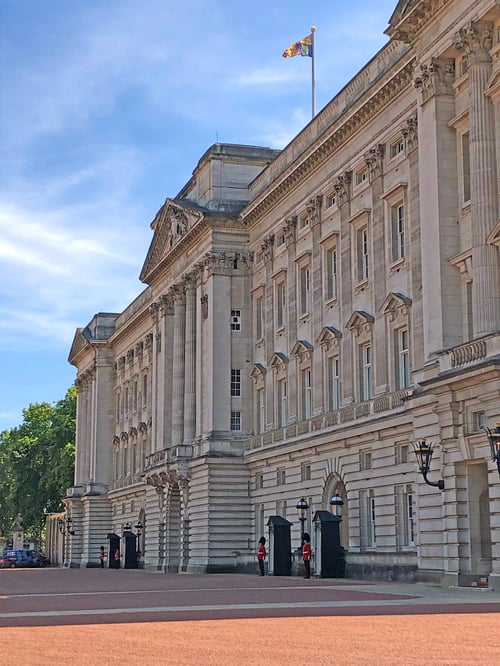
The Changing of the Guard at Buckingham Palace
Most visitors first experience Buckingham Palace from outside the gates, where the Changing of the Guard ceremony takes place several mornings a week (usually Mondays, Wednesdays, and Fridays, though the schedule can vary). The ceremony lasts about 45 minutes and draws big crowds, but it is worth seeing at least once. The precision, music, and pageantry capture what makes royal tradition so distinctively British.
How to Experience the Changing of the Guard
The ceremony begins at 11:00 AM and lasts around 45 minutes, with the New Guard marching from the Wellington Barracks to relieve the Old Guard stationed at the Palace. Accompanied by a full military band, it is one of the best free experiences in London.
For the best view, arrive no later than 10:15 AM and stand along The Mall or at the Victoria Memorial facing the palace gates. Avoid standing directly at the railings of the palace since the crowd compresses quickly and your photos will actually be better from a short distance back.
For the most up-to-date schedule for the Changing of the Guard, please visit The Household Division website. Just be sure to check the schedule for Buckingham Palace and not Windsor Castle.
Inside Buckingham Palace
While the exterior is iconic, Buckingham Palace opens its doors each summer to the public. For roughly ten weeks between July and September, visitors can tour the State Rooms, including many lavishly decorated rooms that are still used for official receptions and royal events. Walking through the Throne Room, the White Drawing Room, and the Grand Staircase offers a glimpse into royal life that feels both opulent and surprisingly intimate.
The Royal Mews
Though smaller and quieter than the palace itself, the Royal Mews is one of the most fascinating royal attractions in London. It is where the horses, carriages, and vehicles used for state ceremonies are kept. It is a working stable that has been in continuous use since the 1820s.
Visitors can see everything from the polished royal Bentleys to ornate coaches used for coronations and royal weddings. The highlight is the Gold State Coach, an enormous gilded carriage that has been used at every coronation of a British monarch since William IV in 1831. Standing before it, you can almost feel the weight of history, and the meticulous care that goes into preserving these pieces of royal heritage.
Jetset Seeker Pro Tip: The Royal Mews is much quieter than the main palace, making it a great stop for those visiting London with kids or anyone interested in the craftsmanship behind royal tradition.
Planning Your Visit to Buckingham Palace
The Buckingham Palace area is one of London’s most walkable and photogenic neighborhoods. Here is what to know before you go.
Public Transportation to Buckingham Palace
Buckingham Palace is located in Westminster, between Green Park and St. James’s Park, and is easy to reach.
- By London Underground (Tube/Metro): The nearest Tube station is Green Park (Jubilee, Piccadilly, Victoria lines), a 5-7 minute walk to the palace.
- By Bus: Routes 6, 13, 38, 52, and 390 all stop near Buckingham Palace.
Opening Hours, Tickets, & More
For the State Rooms at Buckingham Palace:
- From October to May, Buckingham Palace only opens on selected dates for guided tours. For additional information, please visit the Royal Collection Trust website.
- The opening dates for Buckingham Palace for summer 2026 have yet to be announced. For reference, in 2025, the State Room as Buckingham Palace were open to the public from July 10 through September 28. During the summer months, visits to Buckingham Palace are self-guided with an audio guide. Guided tours of the garden are also available.
- Tickets for Buckingham Palace must be booked online, ahead of your visit. Tickets frequently sell out, so the earlier you book, the better. To view ticket options and upcoming tours, please visit the Royal Collection Trust website.
- You should plan to spend a minimum of 90-minutes at Buckingham Palace.
- Photography is not permitted inside of the State Rooms.
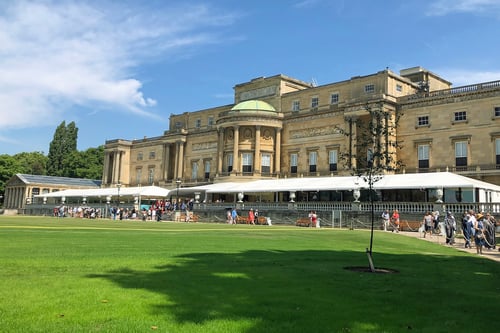
For the Royal Mews:
-
The Royal Mews at Buckingham Palace is open October 26 through November 2, 2025 from 10:00 AM to 4:00 PM. The last admission is one hour before closing.
-
The Royal Mews is closed on Tuesdays and Wednesdays. Since the Royal Mews is part of a working palace, the Royal Mews may close to the public at short notice.
-
Tickets for the Royal Mews at Buckingham Palace can be purchased from the Royal Collection Trust website, in advance of your visit, for a small discount. Discounted tickets are also available for children and groups. An audio guide is included with your admission.
- You should plan to spend about an hour at the Royal Mews. The included audio guide tour lasts approximately 45 minutes.
- The Royal Mews will host its very first festive holiday market this year. From Friday, November 14, 2025 to Monday, January 5, 2026, the Royal Mews at Buckingham Palace will be transformed into a winter wonderland, offering visitors the chance to shop for official royal gifts, decorations, and seasonal treats. While it is not a traditional Christmas market with food stalls or carnival rides, it is a must-visit for royal fans and anyone looking for a unique, festive shopping experience in London at Christmas. For more information, please visit the Royal Collection Trust website.
Westminster Abbey
No royal landmark in London holds more history than Westminster Abbey. Located in the heart of Westminster, just minutes from Buckingham Palace and the Houses of Parliament, Westminster Abbey has been the setting for nearly every British coronation since William the Conqueror in 1066, including the most recent for King Charles III in May 2023.
It is not only the coronation church of the monarchy, but also the site of royal weddings, funerals, and national moments of remembrance. From Queen Elizabeth II’s wedding to Prince Philip in 1947 to Prince William and Catherine Middleton’s ceremony in 2011, Westminster Abbey has witnessed the milestones that define the royal family’s public story.
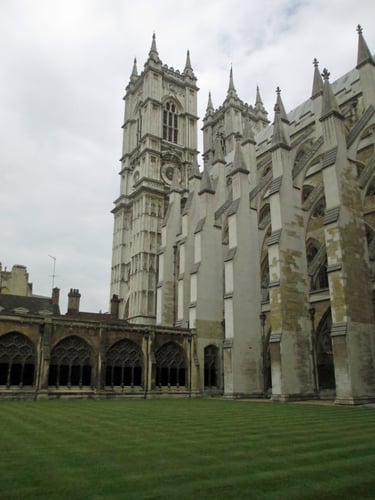
Inside Westminster Abbey
Westminster Abbey’s Gothic architecture is incredible! Think: soaring vaulted ceilings, intricately carved stonework, and vibrant stained-glass windows that flood the nave with color. Every arch tells a story, built over centuries as monarchs expanded and restored the structure. The result is a space that feels both grand and deeply historic.
The Coronation Chair
One of the most important sights inside is the Coronation Chair, crafted in the late 13th century for King Edward I. Though relatively simple in appearance, it is one of the most significant objects in British history as it has been used in every coronation since 1308. During King Charles III’s coronation, it was placed once again before the High Altar, continuing a tradition that has lasted for more than 700 years.
Additional Highlights at Westminster Abbey
Other highlights include the Nave, where sunlight filters through towering stained glass; the Choir, known for its ornate wooden stalls and angelic acoustics; and the High Altar, which remains the spiritual center of royal ceremonies. Even if you have seen the Abbey on television during weddings or state events, standing beneath its stone vaults in person feels entirely different. While I hate to sound cheesy, the scale and the sense of history here are unforgettable.
Notable Burials & Memorials at Westminster Abbey
Beyond its royal legacy, the Abbey is also a national monument to art, science, and literature. More than 3,000 people are buried or memorialized here, including monarchs and visionaries like Charles Darwin, Sir Isaac Newton, and Stephen Hawking. In Poets’ Corner, you will find tributes to Shakespeare, Jane Austen, and Charles Dickens. These memorials are a reminder that Westminster Abbey honors not only Britain’s rulers, but also its creators and thinkers.
How to Visit Westminster Abbey: Tickets, Opening Hours, & More
Westminster Abbey is open for tours Monday through Saturday. Westminster Abbey is closed for tours on Sundays. On weekdays, Westminster Abbey is open from 9:30 AM to 3:30 PM (last entry at 3:30 PM). On Saturdays, Westminster Abbey is open from 9:00 AM to 3:00 PM (last entry at 3:00 PM).
Please keep in mind that on Sundays, Westminster Abbey is only open for services. Services on Sundays, and throughout the week, are free to attend. For the most up-to-date worship schedule, please visit the Westminster Abbey website.
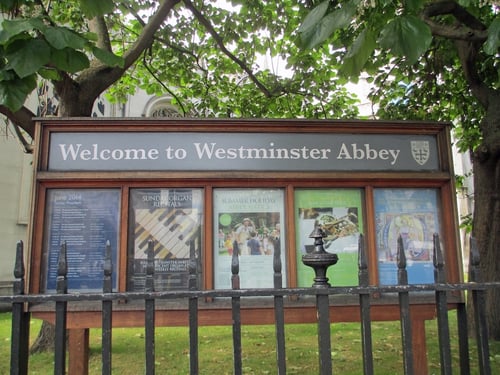
Ticketing Information
I recommend booking your tickets for Westminster Abbey online, in advance of your visit. As one of the most popular royal attractions in London, tickets for the Abbey can sell out, especially during the summer months. On occasion, tickets can only be purchased at the front entrance. However, the Westminster Abbey website will announce these dates in advance.
-
Admission starts £31 for adults. Discounted admission is also available for children, students, and seniors. Admission is free for children under the age of six.
-
Separate tickets are required to visit The Queen’s Diamond Jubilee Galleries. Tickets for The Queen’s Diamond Jubilee Galleries can be booked as an add-on to your general admission tickets. Admission is £5 for adults, while children under 17 can visit free of charge.
-
A multimedia guide is included with admission to Westminster Abbey.
-
All tickets are issued for specific entry times.
Tickets for Westminster Abbey can be booked directly through the Westminster Abbey website. Official tickets can also be secured through our affiliate partner, GetYourGuide. Booking your tickets through GetYourGuide allows you to pay in your home currency (like USD), which can help you avoid foreign transaction fees. Plus, at no cost to you, we may earn a small commission!
London City Pass by MegaPass
While I have already highlighted the London City Pass from our affiliate partner, MegaPass, I want to give it another special mention here. The London City Pass by MegaPass includes entry to Westminster Abbey, other royal attractions in London, and internet data via eSIM. It is one of the best ways to save some money while exploring all that London has to offer!
How to Get to Westminster Abbey
Westminster Abbey is located in Westminster, right in the heart of central London. It sits just west of the Houses of Parliament and Big Ben, and only about a 10–15 minute walk from Buckingham Palace.
- By London Underground (Tube/Metro): The nearest Tube station is Westminster (Jubilee, District, and Circle lines), just a 5-minute walk from the Abbey's entrance.
- By Bus: Routes 11, 24, 26, and 88 all stop nearby.
Tips for Making the Most of Your Time at Westminster Abbey
- Most visitors spend around two hours visiting the Abbey.
- Plan your visit for a weekday morning, if possible. Saturdays tend to be the busiest day to visit.
- Photography is limited in areas inside Westminster Abbey, and completely prohibited inside the Shrine of St. Edward the Confessor, St. Faith’s Chapel, and The Queen’s Diamond Jubilee Galleries. Videography, flash photography, the use of tripods, and selfie sticks is not permitted.
-
After your visit, walk across Westminster Bridge for a postcard view of the Abbey framed by Big Ben and the Houses of Parliament, one of the most iconic scenes in London.
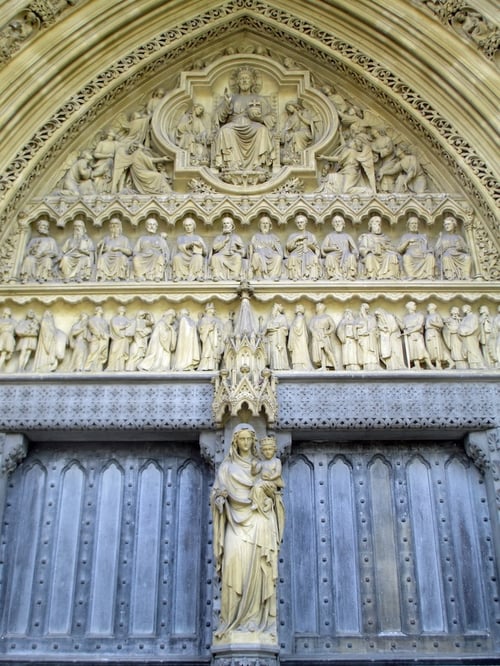
Bonus Royal Attractions & Experiences in London
Once you have covered the classic royal attractions in London, there is plenty more of royal London to uncover. Wander through Kensington Palace, stroll the tree-lined paths of St. James's Park, step back into Tudor-England at Hampton Court Palace, or see the cathedral where Princes Charles and Princess Diana tied the knot. These attractions round out the royal story, showing how the monarchy's influence still touches everyday life across the city.
Kensington Palace
Kensington Palace offers a quieter, more personal glimpse into royal life in London. Kensington Palace is still an active royal residence (the London home of The Prince and Princess of Wales and their children), but much of the palace is open to visitors. Inside, the exhibitions explore the lives of past residents like Queen Victoria and Princess Diana, with displays that range from royal fashion to historic portraits.
Highlights at Kensington Palace
Among the highlights at Kensington Palace are the King & Queen's State Apartments, filled with 17th- and 18th-century art. While grand, they simultaneously feel intimate, designed for private audiences and family life.
Outside, the Kensington Gardens are some of the best in London. Popular among tourists is, of course, the Sunken Garden, which has been recently redesigned in honor of Princess Diana. The Sunken Garden is a peaceful retreat that is especially beautiful in spring and early summer when the flowers are in full bloom.
The Orangery at Kensington Palace
Located next to the palace is easily one of my favorite royal attractions in London: The Orangery at Kensington Palace. The Orangery dates to the 18th-century and was originally built to serve as a greenhouse for citrus trees. Today, it is one of the most atmospheric spots in London for afternoon tea. In addition to afternoon tea, The Orangery serves breakfast and lunch, daily. Reservations for The Orangery are recommended, as walk-ins cannot always be accomodated. For more information and to make a reservation, please visit The Orangery at Kensington Palace website.
How to Visit Kensington Palace: Tickets, Opening Hours, & More
Kensington Palace's opening hours vary based on the season.
- From September through February, Kensington Palace is closed to the public on Mondays and Tuesdays. During the month of September, Kensington Palace is open from 10:00 AM to 6:00 PM, with the last admission at 5:00 PM. From October through February, the palace is open from 10:00 AM to 4:00 PM, with the last admission at 3:00 PM.
- During the month of March, Kensington Palace is closed on most Mondays. The palace is otherwise open from 10:00 AM to 6:00 PM, with the last entry at 5:00 PM.
- From April through August, Kensington Palace is open daily from 10:00 AM to 6:00 PM. The last entry is at 5:00 PM.
- Kensington Palace is closed from December 24-26, annually.
Ticketing Information
Ticket prices vary based on whether any exhibitions being held at the palace, but generally cost anywhere from £20.60 to £24.70 for adults. Admission include access to the King & Queen's State Apartments, the Queen Victoria: A Royal Childhood exhibition, and any rotating exhibitions. Discounted tickets are available for children, students, seniors, and groups.
Tickets can be purchased online through Historic Royal Palaces website. As with most attractions in London, I recommend booking your tickets in advance, especially during the peak summer months.
If you are interested in having afternoon tea at The Orangery at Kensington Palace, advance reservations should be made via The Orangery at Kensington Palace website. Admission to Kensington Palace is not required to enjoy The Orangery.
The Kensington Gardens, including the Sunken Garden, are free to visit and open to the public. For more information, please visit The Royal Parks website.
London City Pass by MegaPass
Like the Tower of London, Westminster Abbey, and some of the other royal attractions in London outlined in this blog post, Kensington Palace is included in the London City Pass by MegaPass.
How to Get to Kensington Palace
Kensington Palace is located within Kensington Gardens in the Royal Borough of Kensington & Chelsea. The palace can be easily reached by public transportation.
- By London Underground (Tube/Metro): There are two Tube stations near Kensington Palace - High Street Kensington (Circle & District) and Queensway Station (Central). Both stations are approximately a 10-minute walk to the palace.
- By Bus: Routes 9, 49, 52, 70, and 452 stop along Kensington High Street, a short walk from the palace entrance.
Tips for Visiting Kensington Palace
- Most visitors spend between 2 to 3 hours exploring the palace's exhibitions and gardens. Although, you should allocate extra time if you are planning on enjoying afternoon tea in The Orangery.
- Included with your palace admission is an audio guide. You can collect your audio guide after you arrive at the palace. The last opportunity to pick up an audio guide is at 3:00 PM, daily. Alternatively, you can listen to the audio guide on your own device via Smartify.
- Photography is permitted throughout most of the palace, though certain objects and areas are off-limits to cameras; clear signage is in place to indicate where photography is not allowed. Flash photography, as well as the use of tripods and selfie sticks, is not allowed.
- After your visit, walk through Kensington Gardens (free and open to the public) to see the Albert Memorial, one of the most atmospheric parts of the gardens. Or, head towards some of the best museums in London nearby in Kensington, including the Victoria & Albert Museum and the Natural History Museum.
St. Paul's Cathedral
Rising above London’s skyline, St. Paul’s Cathedral is one of the most recognizable London landmarks and a key site in British royal history. Designed by Sir Christopher Wren after the Great Fire of London in 1666 and completed in 1710, the cathedral has hosted some of the nation’s most historic ceremonies, including the wedding of Prince Charles and Lady Diana Spencer in 1981 and the Thanksgiving Service for Queen Elizabeth II’s Platinum Jubilee in 2022.
Unlike many of the churches and cathedrals in the United Kingdom that were constructed prior to the Reformation, St. Paul's Cathedral in London was built to be a Protestant cathedral. Today, it serves as the seat of the Bishop of London.
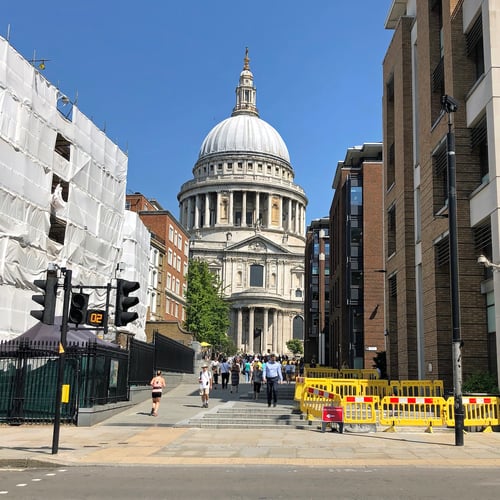
Highlights Inside St. Paul's Cathedral
Inside, the cathedral feels monumental yet calm. Natural light filters through high windows onto pale stone, patterned marble floors, and gilded details that give the interior a quiet sense of order and beauty. The Whispering Gallery, which runs around the inside of the dome, is famous for its acoustics. You can speak softly against the wall and be heard clearly on the opposite side.
Beneath the cathedral lies the crypt, which honors many of Britain’s most distinguished individuals. Though not members of the royal family, their legacies have left an indelible mark on British history. Among them are Sir Winston Churchill, whose state funeral was held here, though he is buried in near his ancestral home in Bladon; Admiral Horatio Nelson, who died aftering being wounded at the Battle of Trafalgar; the Duke of Wellington, who defeated Napoleon Bonaparte at the Battle of Waterloo; and, the Flemish painter Anthony van Dyck, although his remains and tomb were technically interred in the crypt of the original St. Paul's Cathedral which was destroyed during the Great Fire of London in 1666.
The Dome at St. Paul's Cathedral
The best part about visiting St. Paul's Cathedral is the view from its dome. Inspired by Michelangelo's dome at St. Peter's Basilica in the Vatican, the dome at St. Paul's Cathedral rises 365 feet (111 meters). In fact, St. Paul's Cathedral was the tallest building in London for more than 250 years, before the construction of modern skyscrapers. If you climb the 528 steps to the top, the view is worth every one of them. From the Golden Gallery, London stretches out in every direction - the Thames below, Tower Bridge to the east, and the modern skyline rising around it. Admission to the Dome Galleries is included with your general admission to St. Paul's Cathedral.
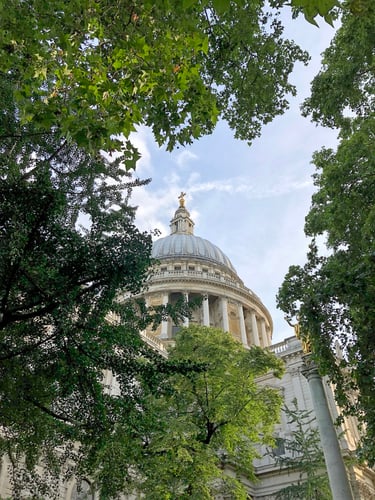
How to Visit St. Paul's Cathedral: Tickets, Opening Hours, & More
St. Paul’s Cathedral is open Monday to Saturday for sightseeing. Daily services are free and open to the public. For more information about daily worship, please visit the St. Paul's Cathedral website.
Please note that opening hours may vary due to services, religious holidays, and special events. I recommend checking the official St. Paul's Cathedral website before your visit.
-
Opening Hours (Except Wednesdays): St. Paul's Cathedral is open from 8:30 AM to 4:30 PM, with the last admission at 4:00 PM. The Dome Galleries open at 9:30 AM with the last entry at 4:15 PM.
-
Wednesdays: Opening hours are slightly reduced on Wednesdays from 10:00 AM to 4:30 PM. The last admission is at 4:00 PM. The Dome Galleries open at 10:00 AM on Wednesdays, with the last admission at 4:15 PM.
- Crypt Café by Benugo: The Crypt Café is open daily, including Sundays. The café can be accessed directly through the northwest Crypt door, no ticket required. The café is open Monday to Saturday from 10:00 AM to 5:00 PM and on Sundays from 11:00 AM to 4:30 PM. For more information, please visit the Benugo website.
Ticketing Information
Tickets for St. Paul's Cathedral are priced at £26 for adults and include entry to the cathedral floor, the Whispering Gallery, the dome, the crypt, and an excellent multimedia guide. Discounted tickets are available for children and groups. Tickets can be booked online at the official St. Paul’s Cathedral website.
London City Pass by MegaPass
Like the Tower of London, Westminster Abbey, and some of the other royal attractions in London outlined in this blog post, St. Paul's Cathedral is included in the London City Pass by MegaPass.
How to Get to St. Paul's Cathedral
St. Paul's Cathedral is located within the City of London, not far from the Tower of London. The cathedral can be easily reached by public transportation.
- By London Underground (Tube/Metro): The closest Tube station is St. Paul's Station (Central). It is about a 3-minute walk from the station to the entrance of the cathedral.
- By Bus: Routes 15, 17, 26, and 76 stop outside of St. Paul's Cathedral.
Tips for Visiting St. Paul's Cathedral
- Most visitors spend 2 hours at St. Paul's Cathedral, giving them time to climb to the top of the dome for fantastic panoramic views of London.
- Photography is permitted inside of St. Paul's Cathedral during sightseeing hours. No flash photography is allowed inside of the cathedral. Tripods, gimbals, and selfie-sticks are also not permitted. Videography is not allowed.
- Complementary guided tours are available inside St. Paul's Cathedral. To book a guided tour, ask upon your arrival to the cathedral as the tour schedules vary based on the day.
- Multimedia guides are also included with your admission to St. Paul's Cathedral. Special multimedia guides are also available for those visiting St. Paul's Cathedral with children.
- Tours of the Triforium (which also includes access to the library, Trophy Room, and other behind the scenes areas) are available to book but come with an additional fee. For more information, please visit the St. Paul's Cathedral website.
- After your visit to St. Paul's Cathedral, walk across the Millennium Bridge to visit Tate Modern or enjoy riverside views from the South Bank.
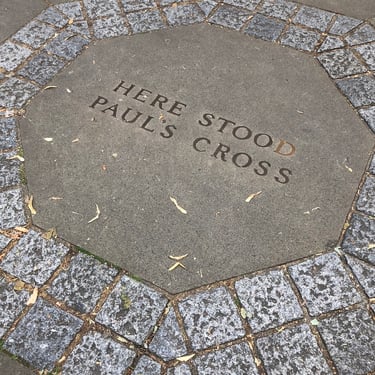
Hampton Court Palace
If you are looking to explore royal attractions in London beyond the city center, Hampton Court Palace is one of the most rewarding day trips you can take from London. Located approximately 12 miles (19.3 kilometers) southwest of London in Richmond upon Thames, it is easy to reach Hampton Court Palace by train from London Waterloo (around 35 minutes). Yet, the palace feels a world away, surrounded by parkland, the River Thames, and peaceful village scenery.
Few places capture the drama of royal history quite like Hampton Court Palace. Originally built for Cardinal Thomas Wolsey in the early 1500s, it was soon claimed by King Henry VIII, who transformed it into his favorite palace. This was where Henry VIII held grand banquets, married two of his six wives, and shaped the early years of the English Reformation. Later monarchs, including William III and Mary II, expanded the residence, adding stately Baroque architecture to its Tudor origins, creating a distinctive mix of styles that still defines the palace today.
Though no longer a royal residence, Hampton Court Palace remains one of the most atmospheric royal attractions in London, offering visitors a rare chance to walk the same courtyards and galleries once filled with courtiers, queens, and political intrigue.
Highlights at Hampton Court Palace
There is plenty to see at Hampton Court Palace. Some of the highlights include:
- The Great Hall: The center of Henry VIII's court and one of the finest surviving medieval halls in England. Its impressive hammer-beam ceiling and intricate woodwork is incredible. However, my favorite part is hiding in plain sight. Look closely at the ceiling and you can see Anne Boleyn's intertwined initials "H&A", carved before her downfall and never removed.
- The Tudor Kitchens: The working heart of the palace, the Tudor Kitchens had more than 200 cooks, bakers, and servants that regularly prepared lavish feasts for the court. These kitchens are among the largest surviving examples in Europe.
- The Chapel Royal: Still an active place of worship, this chapel has been used by monarchs for over 480 years. Its blue and gold vaulted ceiling, commissioned by Henry VIII, is spectacular. It was here that Henry VIII learned, through a letter from the Archbishop of Canterbury, of Catherine Howard’s infidelity—a revelation that marked a defining moment in his tumultuous reign.
- William III's Apartments: A striking contrast to the Tudor rooms, these Baroque apartments reflect the elegance of 17th-century royal life. Built to rival Versailles, they feature grand staircases, grand frescos, and sweeping views over the gardens.
- The Gardens & Maze: Spread across 60 acres, the formal gardens at Hampton Court Palace are meticulously maintained, including the symmetrical Privy Garden and the tranquil Great Fountain Garden. The Hampton Court Maze, planted in the late 1600s, remains one of the world’s oldest hedge mazes and a favorite for visitors of all ages.
- The Haunted Gallery: Perhaps the palace’s most infamous corridor, said to be haunted by Catherine Howard, Henry’s fifth wife. According to legend, she ran screaming down this gallery toward the chapel to plead for her life, only to be dragged away by guards. Catherine Howard was beheaded just three months later at the Tower of London in 1541.
How to Visit Hampton Court Palace: Tickets, Opening Hours, & More
Hampton Court Palace's opening hours vary based on the season.
- From September through February, Hampton Court Palace is closed to the public on most Mondays and Tuesdays. During the months of September and October, Hampton Court Palace is typically open from 10:00 AM to 5:30 PM, with the last entry at 4:30 PM. From November through February, the palace is open from 10:00 AM to 4:00 PM, with the last admission at 3:00 PM.
- During the month of March, Hampton Court Palace will be closed from March 9-13, 2026. The palace is otherwise open from 10:00 AM to 4:00 PM, with the last entry at 3:00 PM.
- From April through August, Hampton Court Palace is open daily from 10:00 AM to 5:30 PM. The last entry is at 4:30 PM.
- Hampton Court Palace is closed December 24-26, annually. Additional closures are announced on the Historic Royal Palaces website in advance.
Ticketing Information
Ticket prices for Hampton Court Palace vary based on peak and off-peak times. Per the palace website, peak times include weekends and public holidays, while off-peak times are weekdays (excluding public holidays). Tickets for adults begin at £28.00. Reduced admission is available for children, students, seniors, and groups.
To purchase tickets for Hampton Court Palace, I recommend booking them directly through the Historic Royal Palaces website, in advance of your visit. Tickets include admission to all open public areas of the palace, the gardens, courtyards, and Maze.
Parts of the palace may close for conservation work. Additional information about conservation work and closures can be found on the Historic Royal Palaces website.
How to Get to Hampton Court Palace
As previously mentioned, Hampton Court Palace is located in Richmond upon Thames, about 12 miles southwest of central London.
- By Train: Take the South Western Railway from London Waterloo to Hampton Court Station (35 minutes). The palace is a 5-minute walk across the bridge. Train tickets do not need to be purchased in advance of your journey. You can simply use tap-to-pay, just as you would on the regular London Underground, to reach Hampton Court Palace by train. For more information about the trains to Hampton Court, please visit the South Western Railway website.
- By Underground & Bus: The London Underground does not run directly to Hampton Court Palace, but you can take the District Line to Wimbledon, then connect to the South Western Railway or take bus routes 111 or 216.
Tips for Visiting Hampton Court Palace
- Due to ongoing conservation work, the main entrance at Hampton Court Palace is closed through June 26, 2026. As such, you will need to enter Hampton Court Palace via the Seymour Gate.
- Visitors should set aside a minimum of a half-day to visit Hampton Court Palace, although you can easily spend a full day exploring the palace and gardens.
- For the smallest crowds (and cheapest tickets), visit on a weekday morning (excluding on a public holiday).
- There are a number of cafés and restaurants at Hampton Court Palace for you to enjoy during your visit. For more information and to view menus, please visit the Historic Royal Palaces website.
- Audio guides are included with your admission to Hampton Court Palace. The audio guides provide expert commentary and helpful information throughout your visit.
- Photography is permitted in most areas of the palace, with the exception of: the Chapel Royal, the Cumberland Art Gallery, and temporary exhibitions. The use of flash photography, tripods, and selfie sticks is prohibited.
- If you find yourself in London at Christmas, Hampton Court Palace transforms into a festive winter wonderland, complete with an open-air ice rink set against the palace façade. It is one of the most picturesque skating spots in the city and a favorite among locals during the holiday season.
Planning Your Royal Day Out
Exploring the royal attractions in London offers a view into both the city's history and its living traditions. From the grandeur of Buckingham Palace to the medieval intrigue of the Tower of London and Hampton Court Palace, each of these London landmarks tell a different chapter of British royal history. While you may not have time to visit all of these incredible places during your time in London, visiting a couple of them can make for an unforgettable day (or two) in the city.
If you are short on time, start with the essentials:
-
Morning: Begin at the Tower of London, ideally right when it opens to beat the crowds and see the Crown Jewels.
-
Midday: Head west toward Westminster Abbey and Buckingham Palace, where you can hopefully time your visit to see the Changing of the Guard. If your visit does not correspond with a Changing of the Guard ceremony, opt to visit Westminster Abbey instead.
-
Afternoon: If you happen to be visiting London while Buckingham Palace is open for tours, take the opportunity to see the incredibly lavish State Rooms, or venture into the Royal Mews to see the state carriages. The Royal Mews was one of my favorite highlights when I visited London as a child. So take my word for it that it makes a great stop for those visiting London with kids!
-
Evening: Cross the River Thames for a peaceful walk along the South Bank with fantastic views of St. Paul’s Cathedral, the Tower of London, and Tower Bridge.
For travelers with an extra day, consider a day trip to Hampton Court Palace. The 35-minute train ride from London Waterloo station makes it an easy addition to any London itinerary, and the palace’s mix of Tudor and Baroque architecture, sprawling gardens, and seasonal ice rink (at Christmas) make it a highlight year-round.
In Summary: Royal Attractions to Add to Your London Itinerary
The best royal attractions in London are not just relics of the past. In fact, they are part of a living tradition that still shapes the city's identity (whether you are pro-monarchy or not)! Whether you are standing beneath the dome at St. Paul's Cathedral, watching the Changing of the Guard at Buckingham Palace, or walking through the Haunted Gallery at Hampton Court Palace, you are visiting places that helped define and shape British history.
A royal day out in London connects history with the present in a way that is authentically British. These landmarks still serve their original purpose - as homes, working palaces, and places of ceremony, which makes visiting them feel alive rather than cold museums.
If you are planning your own royal itinerary, start with the essentials: the Tower of London, Westminster Abbey, and Buckingham Palace. Then, make time for some of the other royal attractions in London, like Kensington Palace, St. Paul's Cathedral, or Hampton Court Palace, where the stories of the British monarchy unfold on a more personal scale.
For more ideas on where to go next, read our full London Travel Blog for hotel recommendations, insider tips, and experiences that go beyond the palace gates.
💬 Have you visited any of London’s royal attractions? We would love to hear your favorites! Share them in the comments below or tell us which royal landmark is next on your list. Happy travels!
%20(1).png?width=3690&height=2079&name=Jetset%20Seeker%20Logo%20(Banner)%20(1).png)
